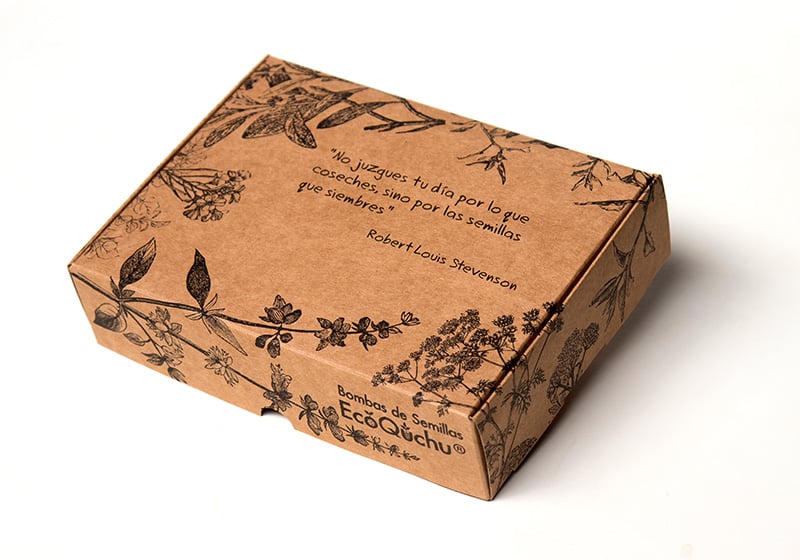Table of Contents
Packaging for Plants
Plant stores have had to reinvent their packaging with sustainability in mind due to the rise of e-commerce.
People who enjoy spending time caring for plants know for a fact that this activity has a positive influence on emotional well-being. This is why, during the first Covid-19 lockdowns in Spring 2020, many homes became filled with greenery, according to a study organised by the Urban Plant Conservation and Biosystems Engineering Research Group (Naturib) of the University of Seville (Spain).
The closure of physical stores and the boom in plant sales led many plant stores to begin selling online. In order to keep up with demand, the sector has had to make major efforts to innovate their packaging, not only in terms of shape and size, but also with their materials, in a world increasingly governed by sustainability criteria.
Designs that generate minimal waste
Plantsome, for example, uses three sizes of boxes in its shipments, which are made of cardboard and use as little plastic as possible inside. This Canadian online plant store, which was created to turn homes and offices into urban jungles with tropical plants, aims to achieve carbon neutrality by 2025. To do this, they say, they are designing tools that will help them accurately determine their daily carbon footprint so they can offset it in innovative ways.

Environmental issues are also a key concern for Plants in a Box, whose nursery recycles 90% of its products and generates minimal waste. The Australian company encourages its customers to reuse the packaging in which they receive their plants for packing or decoration. But when it has to be thrown away, no problem – it is made from bagasse, the waste material left over after the juice is extracted from sugar cane. And what looks like bubble wrap is actually biodegradable corn starch that breaks down easily.

When packaging adds value
Besides being environmentally friendly, some packaging designs provided added value by doubling as a plant base. This is the case of Kayto Natural Design, a Spanish company dedicated to the Japanese art of kokedama. A ball of moss is used instead of a flower pot, representing balance and perfection. For both display at events and delivery to customers, the kokedama is presented in a cardboard structure that opens into a triptych.

Along the same lines there is Tila, a project by three students of the Elisava Packaging Master’s in Spain, winner of a Pentaward award in 2019 and now marketed under the brand Bridepalla. The packaging, created especially for tillandsias – better known as air plants – is constructed with a single cardboard structure and a small recycled PET thread that suspends the plant in the air. It was specifically designed not to waste any material, with an emphasis on the display.

Plantable packaging
While the plants themselves may look spectacular, businesses in this sector usually present them in ugly, plastic, single-use pots. Most people transplant them to new pots when they take them home, throwing away the old one. This was the starting point for Samantha Goh and Jacqueline Vu for their project Hush. The packaging is made from vegetable ink and seed paper, with no glue or adhesives, so it can be planted directly in the soil and avoid any waste.
The company EcoQuchu, headed by a biologist, is dedicated to the design, production and sale of plants and flowers. “Cuchu” or “cucho” is a word used in northern Spain to refer to compost composed of cured manure and vegetable matter, traditionally used for plants due to the organic matter and nutrients it provides for the soil. One of their star products is a seed bomb kit, which can be planted directly in a flowerpot or in soil.

The philosophy behind Garden Pocket, also based in Spain, is to inspire people to grow their own indoor garden with herbs, mushrooms or flowers, or to create their own urban garden with products that combine design and sustainability. The Spanish company achieves this by offering a wide range of gardening products, from glass and reusable containers to grow narcissi, to kits for growing aromatic herbs.
Subscription plants
Finally, we should highlight the latest way to fill your home with greenery: monthly plant subscriptions, which is the business model of the Californian companies Succulent Studio and The House Plant Box. So that volume is not at odds with sustainability, both use 100% plastic-free packaging for their shipments. Succulent Studio’s plants are also organically grown and come planted in coconut fibre and an environmentally friendly pot that degrades in whatever new pot the customer chooses to plant it in.

